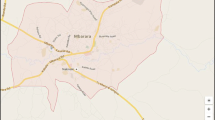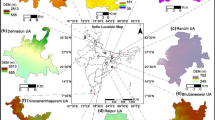Abstract
Shenzhen, located in South China has experienced rapid urbanization over the past three decades. This paper focuses on the urban sprawl integrating remote sensing and geographic information systems (GIS). The overlay of the urban area maps for two adjacent study years was used to generate the sprawl categories map. The three main sprawl categories of infilling sprawl, edge-expansion sprawl and outlying sprawl were calculated and analyzed in regard to their distribution and change throughout different counties during the study years. The result showed that the urban area in the study region had increased dramatically from 19.55 km2 in 1979 to 894.31 km2 in 2005. The urban area centroids over the six study years transferred from southwest to northeast from 1979 to 2005. Among the study counties, the patterns of sprawl categories were markedly distinctive over different study periods. From 1979 to 2005, Shenzhen’s chief spread was outlying sprawl. Bao’an experienced the maximum sprawl within the three study counties. The findings show that studying urban sprawl can provide a method of monitoring urban area change, which, in turn, gives us a clearer perspective of urban sprawl patterns over a longer period of time. This would prove invaluable to those researchers such as land and urban planners.






Similar content being viewed by others
References
Alig R, Healy R (1987) Urban and built-up land area changes in the United States: an empirical investigation of determinants. Land Econ 63(3):215–226
Antrop M (2004) Landscape change and the urbanization process in Europe. Landscape Urban Plann 67(1–4):9–26
Batty M (2005) Agents, cells, and cities: new representational models for simulating multiscale urban dynamics. Environ Plann A 37(8):1373
Berling-Wolff S, Wu J (2004) Modeling urban landscape dynamics: a case study in Phoenix, USA. Urban Ecosyst 7(3):215–240
Burgess E (1925) The growth of the city: an introduction to a research project. University of Chicago, Chicago
Camagni R, Gibelli M, Rigamonti P (2002) Urban mobility and urban form: the social and environmental costs of different patterns of urban expansion. Ecol Econ 40(2):199–216
Clapham W (2003) Continuum-based classification of remotely sensed imagery to describe urban sprawl on a watershed scale. Remote Sens Environ 86(3):322–340
Del Mar López T, Aide T, Thomlinson J (2001) Urban expansion and the loss of prime agricultural lands in Puerto Rico. Ambio 30(1):49–54
Doygun H, Alphan H (2006) Monitoring urbanization of Iskenderun, Turkey, and its negative implications. Environ Monit Assess 114(1):145–155
Ewing R, Pendall R, Chen D (2002) Measuring sprawl and its impact. Smart Growth America, Washington
Fang S, Gertner G, Sun Z et al (2005) The impact of interactions in spatial simulation of the dynamics of urban sprawl. Landscape Urban Plan 73(4):294–306
Gillies R, Brim Box J, Symanzik J et al (2003) Effects of urbanization on the aquatic fauna of the Line Creek watershed, Atlanta-a satellite perspective. Remote Sens Environ 86(3):411–422
Gitas I, Mitri G, Ventura G (2004) Object-based image classification for burned area mapping of Creus Cape, Spain, using NOAA-AVHRR imagery. Remote Sens Environ 92(3):409–413
Harris C, Ullman E (1945) The nature of cities. Ann Am Acad Political Soc Sci 242(1):7
Hasse J, Lathrop R (2003) A housing-unit-level approach to characterizing residential sprawl. Photogramm Eng Rem Sens 69(9):1021–1030
Helmer E, Ruefenacht B (2005) Cloud-free satellite image mosaics with regression trees and histogram matching. Photogramm Eng Rem Sens 71(9):1079–1089
Herold M, Scepan J, Clarke K (2002) The use of remote sensing and landscape metrics to describe structures and changes in urban land uses. Environ Plan A 34(8):1443–1458
Herold M, Goldstein N, Clarke K (2003) The spatiotemporal form of urban growth: measurement, analysis and modeling. Remote Sens Environ 86(3):286–302
Hoyt H (1939) The structure and growth of residential neighborhoods in American cities. Federal Housing Administration, Washington
Huang S, Wang S, Budd W (2009) Sprawl in Taipei’s peri-urban zone: Responses to spatial planning and implications for adapting global environmental change. Landscape Urban Plan 90(1–2):20–32
Keles S, Sivrikaya F, Cakir G et al (2008) Urbanization and forest cover change in regional directorate of Trabzon forestry from 1975 to 2000 using landsat data. Environ Monit Assess 140(1–3):1–14
Li Z, Wu F (2006) Socioeconomic transformations in Shanghai (1990–2000): policy impacts in global-national-local contexts. Cities 23(4):250–268
Luck M, Wu J (2002) A gradient analysis of urban landscape pattern: a case study from the Phoenix metropolitan region, Arizona, USA. Landscape Ecol 17(4):327–339
Martinuzzi S, Gould W, Ramos Gonzalez O (2007) Land development, land use, and urban sprawl in Puerto Rico integrating remote sensing and population census data. Landscape Urban Plan 79(3–4):288–297
Milesi C, Elvidge C, Nemani R et al (2003) Assessing the impact of urban land development on net primary productivity in the southeastern United States. Remote Sens Environ 86(3):401–410
Mitri G, Gitas I (2004) A performance evaluation of a burned area object-based classification model when applied to topographically and non-topographically corrected TM imagery. Int J Remote Sens 25(14):2863–2870
Mouflis G, Gitas I, Iliadou S et al (2008) Assessment of the visual impact of marble quarry expansion (1984–2000) on the landscape of Thasos Island, NE Greece. Landscape Urban Plan 86(1):92–102
Redman C (1999) Human dimensions of ecosystem studies. Ecosystems 2(4):296–298
Seto K, Fragkias M (2005) Quantifying spatiotemporal patterns of urban land-use change in four cities of China with time series landscape metrics. Landscape Ecol 20(7):871–888
Seto K, Liu W (2003) Comparing ARTMAP neural network with the maximum-likelihood classifier for detecting urban change. Photogramm Eng Rem Sens 69(9):981–990
Song Y, Knaap G (2004) Measuring urban form: is Portland winning the war on sprawl? J Am Plan Assoc 70(2):210–226
Sutton P (2003) A scale-adjusted measure of “Urban sprawl” using nighttime satellite imagery. Remote Sens Environ 86(3):353–369
Torrens P, Alberti M (2000) Measuring sprawl (accessed 29 August 2009). http://www.casa.ucl.ac.uk/working_papers/paper27.pdf
Turner M, Costanza R, Sklar F (1989) Methods to evaluate the performance of spatial simulation models. Ecol Model 48(1):1–18
Wilson J, Clay M, Martin E et al (2003) Evaluating environmental influences of zoning in urban ecosystems with remote sensing. Remote Sens Environ 86(3):303–321
Wu J, Loucks O (1995) From balance of nature to hierarchical patch dynamics: a paradigm shift in ecology. Q Rev Biol 70(4):439
Xu C, Liu M, Zhang C et al (2007) The spatiotemporal dynamics of rapid urban growth in the Nanjing metropolitan region of China. Landsc Ecol 22(6):925–937
Yang L, Xian G, Klaver J et al (2003) Urban land-cover change detection through sub-pixel imperviousness mapping using remotely sensed data. Photogramm Eng Rem Sens 69(9):1003–1010
Yeh A, Li X (1999) Economic development and agricultural land loss in the Pearl River Delta, China. Habitat Int 23(3):373–390
Yeh A, Wu F (1996) The new land development process and urban development in Chinese cities. Int J Urban Reg 20:330–354
Acknowledgments
This research was in part supported by the National Natural Science Foundation of China (No. 5006700; No. 40871229). We would especially like to thank the Institute of Geographic Sciences and Natural Resources Research and Guangdong Institute of Eco-environment and Soil Science for their hard work in the basic data preparation. The insightful and constructive comments of the reviewers are appreciated.
Author information
Authors and Affiliations
Corresponding author
Rights and permissions
About this article
Cite this article
Lv, Zq., Wu, Zf., Wei, Jb. et al. Monitoring of the urban sprawl using geoprocessing tools in the Shenzhen Municipality, China. Environ Earth Sci 62, 1131–1141 (2011). https://doi.org/10.1007/s12665-010-0602-7
Received:
Accepted:
Published:
Issue Date:
DOI: https://doi.org/10.1007/s12665-010-0602-7




